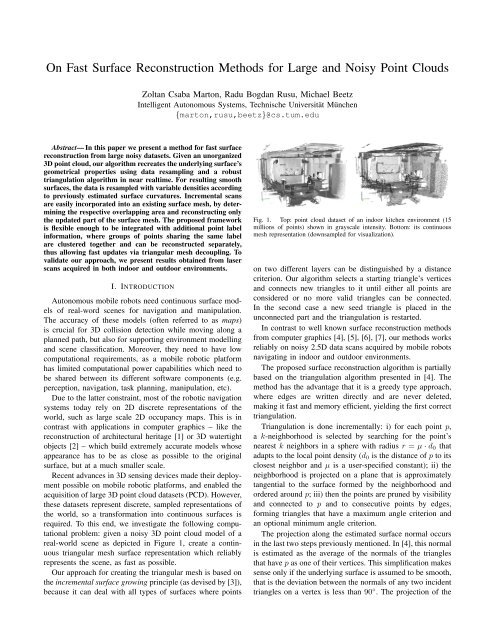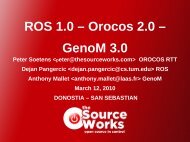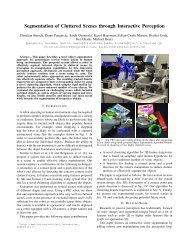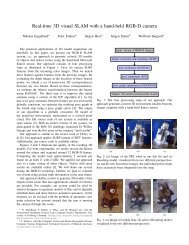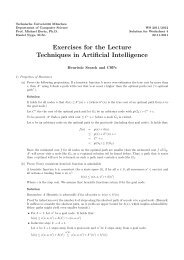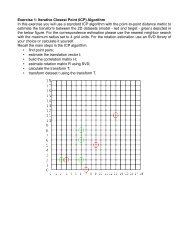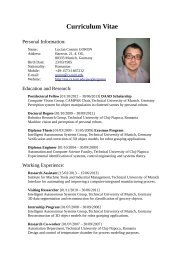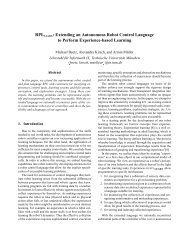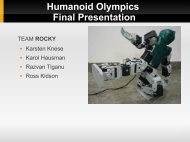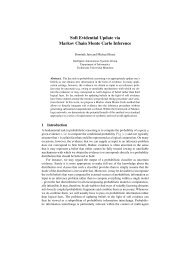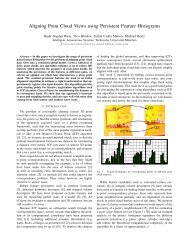On Fast Surface Reconstruction Methods for Large and Noisy Datasets
On Fast Surface Reconstruction Methods for Large and Noisy Datasets
On Fast Surface Reconstruction Methods for Large and Noisy Datasets
Create successful ePaper yourself
Turn your PDF publications into a flip-book with our unique Google optimized e-Paper software.
whole, thus leaving little space <strong>for</strong> further optimizations, like<strong>for</strong> example a parallelization of the triangles computation. Incontrast, the dataset presented in Figure 7 is comprised of22 parts with 252719 points total, where a part is definedby a subgroup of points which share the same attribute orlabel. A triangulation of the entire dataset without using thepoint labels results in a total computation time of 14.842seconds. However, by using the extra in<strong>for</strong>mation present inthe data, we can create each triangle mesh individually, <strong>and</strong>thus parallelize the results. By per<strong>for</strong>ming the reconstructionon 4 different parts at once, the average computation timewas brought down to 3.905 seconds. These results areencouraging <strong>for</strong> the usage of additional point labels notonly <strong>for</strong> dynamic scenes as presented in Section V, but also<strong>for</strong> generating the surface meshes faster by partitioning <strong>and</strong>merging them, using the approach presented in Section IV.Fig. 9. Scan of an approximately 500m long stretch of an urban streetresampled <strong>and</strong> triangulated (top) <strong>and</strong> closeup (bottom left). The triangulationpresented in [4] failed because the dataset does not respect the local uni<strong>for</strong>msampling criterion (bottom right).VII. CONCLUSIONS AND FUTURE WORKIn this paper, we have presented a fast surface reconstructionmethod <strong>for</strong> large <strong>and</strong> noisy point cloud datasets. Ourapproach combines robust resampling methods with a fastprojection-based triangulation method to achieve adaptabilityto variable point densities, <strong>and</strong> noise robustness. To copewith incremental data scans, we derive the overlapping areasbetween existing surface meshes <strong>and</strong> the new datasets, <strong>and</strong>update the existing model without recreating the entire mesh.The per<strong>for</strong>mance of our approach was evaluated ondatasets coming from both indoor <strong>and</strong> outdoor environments,<strong>and</strong> the results are promissing <strong>for</strong> online surface generation<strong>for</strong> 3D path planning <strong>and</strong> collision detection on a mobilerobotic plat<strong>for</strong>m.Additionally, our reconstruction method supports extrain<strong>for</strong>mation present in the dataset, such as point labelsor attributes which can be grouped to cluster subsets ofpoints together. This concept was validated in Section V <strong>and</strong>provides a good starting point <strong>for</strong> online, fast mesh updates<strong>for</strong> dynamic scenes.Future plans include improving the robustness of ouralgorithm by better h<strong>and</strong>ling special triangulation cases dueto the high degree of noise. In this respect, we are targetingthe usage of our methods on point cloud data generated byTOF (Time Of Flight) cameras.ACKNOWLEDGEMENTSThis work is supported by the CoTeSys (Cognition <strong>for</strong>Technical Systems) cluster of excellence. We thank thepeople at ISPRS <strong>for</strong> giving us access to the Ljubljana urb<strong>and</strong>atasets, as well as Radiohead <strong>for</strong> the Lidar scan data.REFERENCES[1] M. Levoy, K. Pulli, B. Curless, S. Rusinkiewicz, D. Koller, L. Pereira,M. Ginzton, S. Anderson, J. Davis, J. Ginsberg, J. Shade, <strong>and</strong> D. Fulk,“The Digital Michelangelo Project: 3D Scanning of <strong>Large</strong> Statues,”in SIGGRAPH ’00: Proceedings of the 27th annual conference onComputer graphics <strong>and</strong> interactive techniques. New York, NY, USA:ACM Press/Addison-Wesley Publishing Co., 2000, pp. 131–144.[2] M. Gopi, S. Krishnan, <strong>and</strong> C. T. Silva, “<strong>Surface</strong> <strong>Reconstruction</strong>Based on Lower Dimensional Localized Delaunay Triangulation,” inComputer Graphics Forum (Eurographics 2000), vol. 19(3), 2000.[3] R. Mencl <strong>and</strong> H. Müller, “Interpolation <strong>and</strong> approximation of surfacesfrom three-dimensional scattered data points,” in State of the ArtReports, Eurographics ’98, 1998, pp. 51–67.[4] M. Gopi <strong>and</strong> S. Krishnan, “A <strong>Fast</strong> <strong>and</strong> Efficient Projection-BasedApproach <strong>for</strong> <strong>Surface</strong> <strong>Reconstruction</strong>,” in SIBGRAPI ’02: Proceedingsof the 15th Brazilian Symposium on Computer Graphics <strong>and</strong> ImageProcessing, 2002, pp. 179–186.[5] C. E. Scheidegger, S. Fleishman, <strong>and</strong> C. T. Silva, “Triangulating pointset surfaces with bounded error,” in SGP ’05: Proceedings of the thirdEurographics symposium on Geometry processing, 2005, p. 63.[6] N. Amenta, S. Choi, <strong>and</strong> R. K. Kolluri, “The power crust,” in SMA’01: Proceedings of the sixth ACM symposium on Solid modeling <strong>and</strong>applications. New York, NY, USA: ACM Press, 2001, pp. 249–266.[7] T. K. Dey <strong>and</strong> S. Goswami, “Tight cocone: a water-tight surfacereconstructor,” in SM ’03: Proceedings of the eighth ACM symposiumon Solid modeling <strong>and</strong> applications, 2003, pp. 127–134.[8] J. Wang <strong>and</strong> M. M. Oliveira, “A Hole-Filling Strategy <strong>for</strong> <strong>Reconstruction</strong>of Smooth <strong>Surface</strong>s in Range Images,” XVI Brazilian Symposiumon Computer Graphics <strong>and</strong> Image Processing (SIBGRAPI), vol. 00,p. 11, 2003.[9] S. Arya <strong>and</strong> D. M. Mount, “Approximate Nearest Neighbor Searching,”in Proc. of 4th Ann. ACM-SIAM Symposium on Discrete Algorithms(SODA’93), 1993, pp. 271–280.[10] R. B. Rusu, Z. C. Marton, N. Blodow, M. Dolha, <strong>and</strong> M. Beetz,“Towards 3D Point Cloud Based Object Maps <strong>for</strong> Household Environments,”Robotics <strong>and</strong> Autonomous Systems Journal (Special Issueon Semantic Knowledge), 2008.[11] M. Alexa, S. Rusinkiewicz, M. Alexa, <strong>and</strong> A. Adamson, “<strong>On</strong> normals<strong>and</strong> projection operators <strong>for</strong> surfaces defined by point sets,” in InProceedings of Eurographics Symposium on Point-based Graphics,Eurographics, 2004.[12] M. Pauly, M. Gross, <strong>and</strong> L. Kobbelt, “Efficient Simplification of Point-Sampled <strong>Surface</strong>s,” in Proceedings of IEEE Visualization, 2002.[13] P. Torr <strong>and</strong> A. Zisserman, “MLESAC: A new robust estimator withapplication to estimating image geometry,” Computer Vision <strong>and</strong>Image Underst<strong>and</strong>ing, vol. 78, pp. 138–156, 2000.[14] R. B. Rusu, N. Blodow, Z. C. Marton, <strong>and</strong> M. Beetz, “Aligning PointCloud Views using Persistent Feature Histograms,” in Proceedings ofthe 21st IEEE/RSJ International Conference on Intelligent Robots <strong>and</strong>Systems (IROS), Nice, France, September 22-26, 2008.[15] R. B. Rusu, Z. C. Marton, N. Blodow, <strong>and</strong> M. Beetz, “LearningIn<strong>for</strong>mative Point Classes <strong>for</strong> the Acquisition of Object Model Maps,”in Proceedings of the 10th International Conference on Control, Automation,Robotics <strong>and</strong> Vision (ICARCV), Hanoi, Vietnam, December17-20, 2008.


